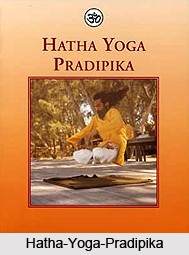Hatha Yoga Pradipika is one of the best known and most widely available treatise on hatha-yoga. Pradipika literally means "that which sheds light", and hence the title of this work translates as "Light on, or illumination of, hatha-yoga". The author of this detailed work is suppose to be Svatmarama Yogendra in the fourteenth-century C.E.
 However, Hatha Yoga Pradiika is better known as the compilation rather than the original work as much of its material resembles, or even precisely duplicates, passages from other hatha manuals. Many inspired works are attributed to Goraksha.
However, Hatha Yoga Pradiika is better known as the compilation rather than the original work as much of its material resembles, or even precisely duplicates, passages from other hatha manuals. Many inspired works are attributed to Goraksha.Hatha Yoga Pradipika comprises a total of 389 Shlokas (A Sanskrit verse usually consisting of two pithily composed lines). The work is divided into four chapters containing 67, 78, 130 and 1 14 shlokas respectively.
The Initial most and the most important chapter or "prathamopadesa" deals mainly with the right environment for hatha practice, certain ethical requirements, and the yoga-asanas or 'postures'.
The Dvitayopadesa (second lesson) principally concerns pranayama as the 'harnessing' of vital energy through various modes of 'retention' (Kumbhaka). It also discusses the sat-karmani (six cleansing acts) which deals with the purification of body, vital channels (nadis) and rectifying all Doshas.
In Trtiyopadesha (third lesson), the extensive coverage of mudra (sealing) is addressed.
Chaturtho-padesa (fourth lesson) discusses the practice of nada-anusandhana (meditation upon the inner sound). There is detailed description on state of samadhi, which in its highest form is the ultimate goal of yoga and which leads to that goal.
The crisp description of Hatha Yoga Pradipika is assisted by several commentaries on the same work. The best known work is that of Jyotsna ('Light', Illumination') of Brahmananda. This work itself quotes extensively from other works of Indian philosophy. Brahmananda's commentary ackowledges how Svatmarama's text relates to the broader context of yoga and to the ashtanga yoga system of Patanjali in particular. Other major commentaries include those by Umapati, Mahadeva, Ramananda Tirtha, and Vrajabhusana.
There have been many applaudable works as the English transalation of the work along with the commentaries.
For more, visit the link below: